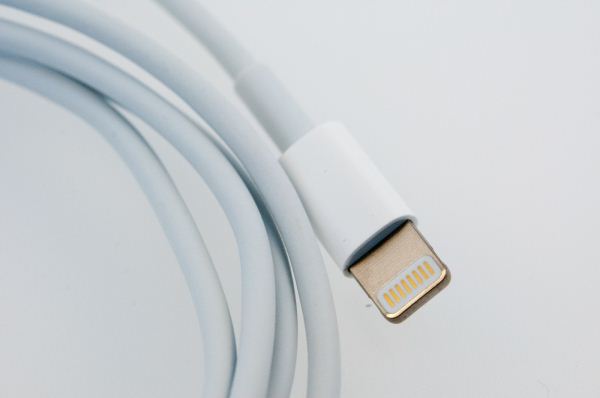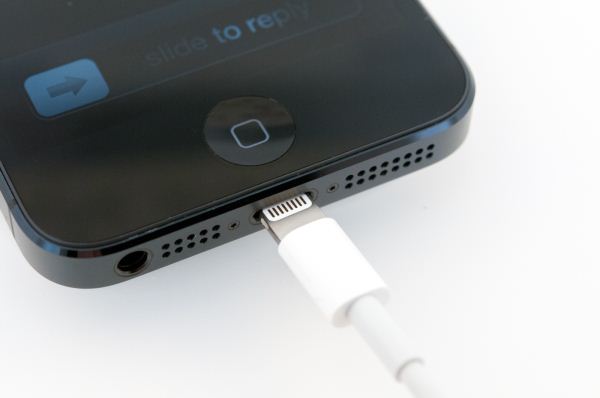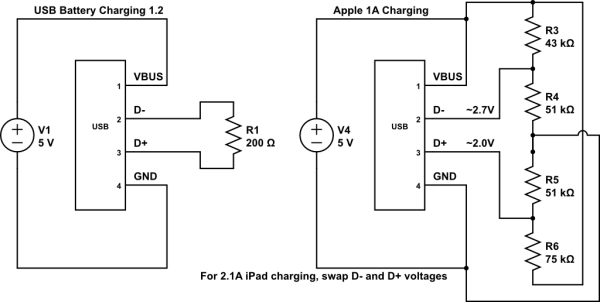The iPhone 5 Review
by Anand Lal Shimpi, Brian Klug & Vivek Gowri on October 16, 2012 11:33 AM EST- Posted in
- Smartphones
- Apple
- Mobile
- iPhone 5
Lightning 9-pin: Replacing the 30-pin Dock Connector
Section by Brian Klug
With the iPhone 5 and the corresponding iPod lineup refresh, Apple has moved away from the venerable 30-pin dock connector and onto a new 9-pin Lightning connector. The Lightning connector announcement caused a considerable amount of chatter in the Apple ecosystem primarily because of just how ubiquitous 30-pin accessories became in the years that Apple used that as the primary interface for everything iPod, iPad, and iPhone.
Over years of iDevice upgrades I wager most people have built up a considerable inventory of both 30-pin dock cables, chargers, and Made For i (MFi) accessories. Moving to a completely new interface warrants at the very least the purchase of new cables. Even in my own case this is a friction point, as I managed to snag an extra long 30-pin dock cable Apple uses in their displays for use on my nightstand, and there’s no equivalent at the moment for Lightning. At bare minimum I require three cables — one for the nightstand charger, one for in the car, and one for connecting to a computer. I’m willing to bet most other users are the same. In the days right after the iPhone 5 launch Lightning to USB cables were hard to come by both at carrier stores and Apple stores (one Verizon store told me their entire Lightning cable stock had been recalled), but by now stock of more Lightning to USB cables is getting better but still rather limited.
The new connector is both considerably smaller in overall volume than the old 30-pin, and fully reversible as well. On the Lightning male connector there are 8 exposed gold pads, with the metal support serving as the 9th pin and ground. As best I can tell, these are mapped in a rotational fashion not through the connector but rather so that the bottom left pin maps to the top right pin if looking top down. As an aside, I’ve seen people refer to the 9-pin as 8-pin because of this ground, which is puzzling, in spite of Apple even calling it a 9-pin internally (eg. “IOAccessoryDock9Pin”=1). The old 30-pin pinout had 7 pins dedicated to ground, yet everyone resisted calling it a 23-pin, but I digress.
Lightning of course does away with lots of the signaling that went unused on the older 30-pin adapter that previously accommodated the older iPod touch lineup. Things like 12 volt FireWire charging and data that went away a long time ago, and older analog video out compliance.
Apple calls Lightning an “adaptive” interface, and what this really means are different connectors with different chips inside for negotiating appropriate I/O from the host device. The way this works is that Apple sells MFi members Lightning connectors which they build into their device, and at present those come in 4 different signaling configurations with 2 physical models. There’s USB Host, USB Device, Serial, and charging only modes, and both a cable and dock variant with a metal support bracket, for a grand total of 8 different Lightning connector SKUs to choose from. At present by USB over Lightning I mean USB 2.0.
With Lightning, Apple officially has no provision for analog audio output, analog video output, or DisplayPort. That said special 3rd party MFi members will no doubt eventually get (or may already have) access to a Lightning connector for DisplayPort since obviously video out over a wired interface must continue. For audio output, Lightning implements USB audio output which looks like the standard USB audio class. This has been supported for a considerable time on the old 30-pin adapter, though most accessory makers simply chose to use analog out for cost reasons. I originally suspected that analog line-out would come over the 3.5mm headphone jack at the bottom of the iPhone (thus all the dockable interfaces at the bottom), but the iPod Nano 7G effectively threw that prediction out the window with its headphone jack placement.
Thus, the connector chip inside isn’t so much an “authenticator” but rather a negotiation aide to signal what is required from the host device. Lightning implicitly requires use of one of these negotiation components, and in addition Apple still requires authentication hardware using certificates for every accessory that uses iAP (iPod Accessory Protocol). With Lightning Apple introduced iAP2 which is a complete redesign of iAP, the protocol which allows for playback control, communication with iOS applications, launching corresponding iOS apps, GPS location, iPod out, and so forth.
When it comes to the physical layer of Lightning there’s very little information out there regarding whether the Lightning chip is doing conversion from some other protocol or simply negotiating USB, Serial, or so forth, and then waiting for the host device to route those I/Os over the cable. You can imagine that with DisplayPort there will need to be some active component that multiplexes USB, DisplayPort, and supplies power over the 9 pins, so I suspect some other protocol on top of all this.
The new connector of course necessitates a new cable and new line of accessories. Probably the biggest inconvenience is that with the iPhone 5 there’s now even less of a chance you can snag a quick charge at a friend’s house or in a friend’s car unless they too have an iPhone 5. While that’s not an entirely fair criticism, the reality of smartphone battery life at the moment means that charging whenever or wherever you can is an important factor, and in ecosystems other than iOS land I’m spoiled by the ubiquity of microUSB. Another consideration is what happens in the case where a household has both devices with Lightning and the 30-pin connector — at present it looks like the solution is either multiple cables for the car charger or an adapter.
That brings me to the microUSB to Lightning adapter, which, like the microUSB to 30-pin dock adapter that came before it isn’t available in the USA but is available in Europe and elsewhere. At present the only way to get one of these in the states is to pay considerable markup and buy on eBay or have a friend ship one from abroad (I opted for the latter option, thanks to our own Ian Cutress). It’s unfortunate that Apple won’t sell you one of these stateside but rather forces you into buying cables. The Lightning to microUSB adapter supports both charging and sync/data functionality. I can’t understate that the Lightning to microUSB adapter is tiny, absolutely tiny. I thought the microUSB to 30-pin adapter was small and always at risk of becoming lost in the aether, well the Lightning equivalent is even smaller.
The reason for this disparity is that the EU mandated a common external power supply standard which implements the USB charging specification and uses microUSB as the connector. To skirt this requirement Apple made the original 30-pin dock connector available, and this time around has made a Lightning adapter available as well. The somewhat important and oft-overlooked context here is that Apple had standardized the 30-pin dock connector and its own 5 volt charging signaling before the GSM Association, International Telecommunication Union, or EU decided to implement the USB charging spec, and before even the USB-IF finished the charging spec. There’s a tangent here that’s worth discussing, and it’s how these two differ in signaling that a USB port has more than the standard 500 mA at 5V available from a USB 1.x or 2.0 port.
In the case of the USB Battery Charging 1.2 specification, signaling is actually superficially pretty simple, and boils down to sticking a 200 Ohm resistor across the D- and D+ pins. You can do this yourself and test with an external power supply, it works with almost every new device intended to be used with USB chargers. Apple however needed a 5V charging specification before the industry implemented it, and went with what boils down to two simple voltage dividers that drive 2.8 and 2.0 volts across D- and D+ respectively. If you go shopping around for USB charging controllers, you’ll see this referred to in the open as the Apple voltage divider. Anyways, my long winded point is that the microUSB to 30-pin and Lightning adapters contain a circuit of some kind to accommodate the difference in charging specification and deliver more than the 500 mA at 5V you’d get otherwise. What’s curious to me is that this time around using the Lightning to USB adapter plugged into a simple circuit simulating a USB BC 1.2 charger, I get the same current draw (around 0.8 A at 5V at maximum) as I do with Lightning to microUSB to the circuit.
Of course for accessories with dock connectors that aren’t on a fast replacement cycle (for example cars and AV receivers) users can opt to buy the 30-pin adapter for legacy dock accessories. This adapter of course includes a number of active components to talk with Lightning. While I haven’t tested this myself due to availability reasons, I’ve heard that it works fine with devices from the iPod 4th Generation days with serial iAP, no authentication chip, and analog audio. While video out isn’t supported on the 30-pin to lightning adapter, it sounds like the adapter does handle analog and USB audio out alongside charge and USB data.
Finally the last important angle is what happens for accessories that need to accommodate both older 30-pin devices and those with the new Lightning port. Apple’s guidance is pretty simple, it plainly disallows accessories from including both connectors, and instead wants manufacturers to adopt a modular plug assembly that presents one or the other at a time. The other solution is to simply use USB and the corresponding cable, but for docks that isn’t really a practical solution.
The reality of the 30-pin dock connector from 2003 is that it has been destined for a more modern, compact replacement for some time now. If you look at the actual pinout, a shocking number are devoted to I/O that simply wasn’t used anymore, and inspecting your average dock to USB connector and counting how many pins were actually there really drove home the reality that Apple was wasting a lot of space at the bottom of its devices. Volume gains from Lightning are really what enabled Apple to both redesign the speakerphone acoustic chamber, bottom microphone, and relocate the headphone jack on the iPhone 5.















276 Comments
View All Comments
medi01 - Wednesday, October 17, 2012 - link
1) Compare ipad2's gamut, cough2) Check values on toms
http://media.bestofmicro.com/3/4/331888/original/g...
http://www.tomshardware.com/reviews/ipad-3-benchma...
Unlike anand, toms was beyond primitive contrast/brightness benchmarking for quite a while.
thunng8 - Thursday, October 18, 2012 - link
Not sure if I should trust Tom's figures compared to Anands's.In any case, both show the ipad3 has higher gamut, especially in sRGB.
steven75 - Wednesday, October 17, 2012 - link
I think what you meant to say is that AMOLEDs win on black levels and that's about it. LCDs still win in accuracy and most importantly ability to see them in outdoor settings.KoolAidMan1 - Tuesday, October 16, 2012 - link
Not even close. Even the better Android displays like the Galaxy S3 has a PenTile display. Despite having more "pixels" it actually has fewer subpixels than the iPhone does. Unless you have bad eyesight the S3 display looks really bad in comparison, and this is before we get to even worse smartphone displays out there by HTC, etc.Sufo - Tuesday, October 16, 2012 - link
Old pentile displays were visibly jaggy on vertical lines - even my old lumia 800 exhibited this to some extent. On the GS3 tho, it is not noticeable and it has nothing to do with eyesight.Your comment makes it sound (to someone who has seen many different smartphone displays in person) as though you haven't spent much time with the GS3 (read: many smartphones) at all. Simply mentioning that is uses pentile subpix config, from you, sounds like regurgitated information. Not only that, but you seem to gloss over the many benefits that amoled panels bring. It's arguable that these benefits are more important than an accurate colourspace on (specifically) a mobile phone - although it is ofc entirely subjective.
This brings me to the last tell of ignorance I noted; your mention of HTC. Have you used a One X? For those who do not like amoled panels, the display on the one x is perhaps nicer than both the gs3 and the ip5. Ofc you may say Android is not your cup of tea, and that's a perfectly justifiable stance, however it has nothing to do with display tech.
tl;dr You sound like you don't know what you're talking about
KoolAidMan1 - Tuesday, October 16, 2012 - link
I do know what I'm talking about given that I've seen many smartphones, and I've calibrated my share of desktop displays to sRGB.Differences in display tech aside, Android phones have never gotten color profiles right, EVER. They're almost always oversaturated, have too much contrast, and are inaccurate. Anand even posted a difference in color accuracy between several devices, and the profile for the S3 is totally what I expected.
The S3 really doesn't look good, period, but then again there are people who argue that TN panels are just fine against IPS. I'm used to hearing nonsense on forums when it comes to display from people who don't know what to look for.
KoolAidMan1 - Tuesday, October 16, 2012 - link
BTW, apologies if that came out harsh, but the difference in color and contrast accuracy between something like the S3 and a properly calibrated device is a night and day difference to me. I'm pretty sensitive to display quality though; my main desktop display at home is still an NEC and my plasma is a Pioneer Elite (RIP)rocketbuddha - Tuesday, October 16, 2012 - link
For Android you have the following 720p HD DisplaysSLCD - HTC Rezound (2011 tech)
SLCD 2 - HTC One X, Sony HD
HD SAMOLED Pentile - GS3, Galaxy Nexus, Moto Razr HD
HD SAMOLED RGB - Galaxy Note II
True IPS LCD - LG Optimus 4X, Optimus G
Super IPS LCD -Asus Padphone, Sharp phones etc
So you have big set of choices. If dark contrasts are important then SAMOLED is the way to go. SAMOLED RGB over SAMOLED Pentile.
If overall color and whites are important go with SLCD2.
IPS LCDs are the closest to the Retina Display and u have a choices there too. You can pick and choose what is good for you and have alternatives.
Spunjji - Thursday, October 18, 2012 - link
The HTC One X has what is hailed to be one of the best LCD smartphone displays out there. Your claim is invalid.Similarly, the Galaxy Note 2 has an AMOLED display without PenTile. Sure, it's lower density, but one does not hold a 5.5" screen so close to one's face.
medi01 - Wednesday, October 17, 2012 - link
""The iPhone 5 display is better than any current Android display.""Why don't you go hit your dumb head with something heavy, ipad would do?